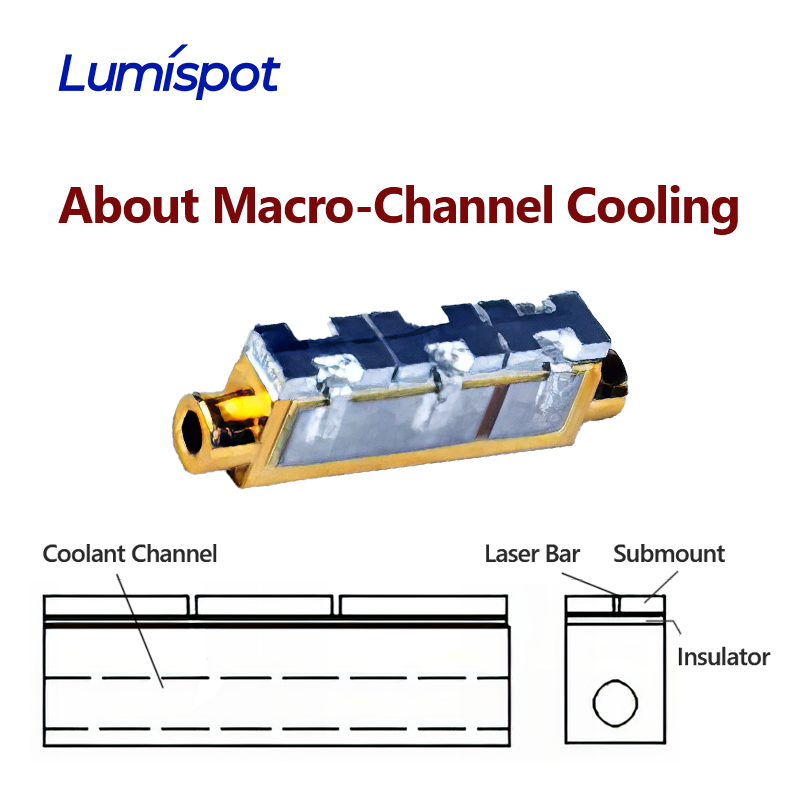In applications such as high-power lasers, power electronic devices, and communication systems, increasing power consumption and integration levels have made thermal management a critical factor affecting product performance, lifespan, and reliability. Alongside micro-channel cooling, macro-channel cooling has emerged as a practical liquid-cooling solution. Its simpler structure, lower cost, and easier maintenance make it highly suitable for many industrial scenarios.
1. What Is Macro-Channel Cooling?
Macro-channel cooling involves the use of larger coolant flow channels (typically in the millimeter range) built into cooling plates or modules. These channels guide coolant fluids—commonly deionized water, glycol-based solutions, or other industrial coolants—through the system to remove heat generated during device operation. When integrated with a water-cooling loop, this setup enables continuous and efficient thermal control.
2. Macro-Channel vs. Micro-Channel: Key Differences
|
Feature |
Macro-Channel Cooling |
Micro-Channel Cooling |
|
Channel Size |
Millimeter-scale (1mm to several mm) |
Micrometer-scale (tens to hundreds of μm) |
|
Fabrication Complexity |
Relatively low |
Requires high-precision machining |
|
Flow Resistance |
Low, fluid flows easily |
High, needs higher pump pressure |
|
Heat Exchange Efficiency |
Moderate, suitable for medium heat flux |
High, ideal for extreme heat flux |
|
Cost |
Lower |
Higher |
|
Typical Application |
Medium-to-low heat flux, high reliability systems |
High-power density, localized heat sources |
3. Advantages of Macro-Channel Cooling
Although its thermal efficiency is lower than micro-channel solutions, macro-channel cooling offers several notable benefits:
① High reliability:
Wider channels are less prone to clogging, offering excellent long-term stability—ideal for continuous industrial operation.
② Lower manufacturing costs:
Simpler structure and diverse fabrication options make it suitable for mass production.
③ Ease of maintenance:
Long cleaning intervals, low maintenance costs, and less stringent coolant purity requirements.
④ Adequate cooling capacity:
For devices with moderate heat flux, macro-channel cooling effectively maintains optimal operating temperatures and extends device lifespan.
4. Application Scenarios
Macro-channel cooling is widely used in the following areas:
① Laser modules:
Especially for mid- to low-power or CW-mode lasers, macro-channel systems can easily handle the thermal load.
② Power electronic modules:
Such as rectifiers, DC-DC converters, and IGBT modules.
③ Power amplifiers in communication and radar systems:
Ideal for complex environments requiring long-term, stable operation.
④ Cooling systems in medical and industrial equipment:
Including semiconductor laser therapy devices, laser marking machines, and more.
5. Key Design Considerations for Macro-Channel Cooling
A successful macro-channel cooling solution requires attention to the following factors:
① Channel layout:
Should be optimized based on the device’s heat source distribution to achieve uniform cooling.
② Material selection:
Copper, stainless steel, or aluminum alloys are commonly used for their high thermal conductivity and corrosion resistance.
③ Flow rate and pump compatibility:
Proper design of fluid speed and coolant flow ensures efficient heat exchange and system stability.
④ Standardized interfaces:
Enables easy integration into customer devices or modules.
6. Conclusion
Macro-channel cooling continues to play a vital role in industrial applications due to its simplicity, reliability, and ease of maintenance. It is a cost-effective and dependable solution, especially in systems with medium to low thermal densities. As device design evolves, macro-channel solutions are also advancing toward higher integration and improved adaptability.
7. About Us
Lumispot offers extensive expertise in both macro-channel and micro-channel thermal management solutions. We provide customized cooling modules for lasers, optoelectronic devices, power electronics, and more. Our focus goes beyond thermal performance—we prioritize system integration and long-term reliability, aiming to deliver high-performance, cost-effective cooling systems.
Feel free to contact us to learn more about macro-channel and micro-channel cooling solutions tailored to your application needs!
Post time: Jun-17-2025

